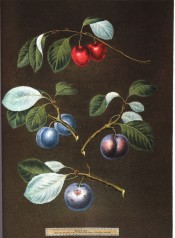Prunus domestica L.
Deciduous tree, occasionally spiny, with elliptic or oblong leaves, the flowers white with up to four in a cluster, followed by a pendant oval fruit, from yellow to dark blue in colour, the flesh edible, green, reddish or yellow, with an almost smooth stone. To 12m. [RHSD, Hortus].
Horticultural & Botanical History
‘The plums of today have derived from a number of species over thousands of years. In Europe, including Britain, the sloe or blackthorn (Prunus spinosa) and the bullace (P. institia) are widespread, while the cherry or plum myrobalan (P. cerasifera) is native of southwest Russia bordering on the Caspian Sea. The plum as grown in Britain and Europe today [which includes almost all of the plums described in the Hortus] is now classified as P. domestica and is considered to have arisen, in its many forms (both shape and colour) from hybridisation between P. cerasifera and P. spinosa in southwest Asia/southeast Europe, whence the various selections were gradually spread and introduced over many centuries in a westerly and northwesterly direction.
The main groups of plums are as follows:
1. P. domestica, with wide variations in shape, size and colour. Several distinct types are distinguishable, including Reine Claude or Greengage types, with round fruits, green with cerise marblings and with a rich sweet flavour; Transparent Gage type with partially transparent skins, through which the outline of the stone is visible; Prune types, purple-skinned and usually with a high sugar content and an affinity to successful drying. Many P. domestica cultivars are grown in Europe, the U.S., Australia, New Zealand and South Africa, especially in the cooler areas.
2. Damson. Selections from P. institia with small purple-black, oval, often necked fruits, initially astringent and acid but often with a richer, sweeter flavour when fully ripe. Typically listed as ‘Damson’.’ [The two other major groups are Cherry Plums and Salicine but they do not concern us here.] […]
The Romans were responsible for introducing different types of plum into Britain. From these, seedlings arose in the wild increasing the potential for further development, with time, in association with the indigenous populations of P. institia and P. spinosa. However, until the 16th century plums were dried and preserved rather than eaten as fresh fruit. With the enthusiasm for fruit-growing that flourished during the reign of Henry VIII, new and sometimes richly flavoured cultivars were introduced from the Continent, particularly France, with some fine prune types from the Balkans. By the early 1700s many varieties were being propagated by nurserymen and the famous ‘Coe’s Golden Drop’ [which see] was bred towards the end of the century. It arose from a stone of ‘Green Gage’ [which see], a cultivar that had reputedly originated in Armenia and had been introduced to Italy, then to France and so to Britain. In France it was known as ‘Reine Claude’ [which see] (hence the Reine Claude type in the classification) and is still widely grown there. The name ‘Green Gage’ arose because a consignment of trees sent by John Gage, a priest living near Paris early in the century, was received by his brother in Suffolk with the label missing from ‘Reine Claude’ trees. He then proceeded to name the cultivar ‘Green Gage’ after his brother.
By the early 19th century many excellent cultivars existed in Britain and the Horticultural Society listed 281 in its collection, though many were synonyms and more still worthless. No major or organised progress in the introduction of new cultivars occurred until, under the influence of the Horticultural Society and of Andrew Knight, the leading nurserymen Thomas Rivers and Thomas Laxton embarked on what was to become a long and famous association with fruit and fruit breeding. Their ascendancy coincided with the period of the Victorian kitchen garden, for which new cultivars were constantly sought, and this situation continued until the final decline of the large estates after world War II. Numerous fine cultivars were introduced during this period, some of which are still widely listed today, and concurrently cultivars reached other parts of the world.’ [RHSD/1999].
History at Camden Park
26 varieties of plum are described in the Hortus. Some are arguably synonymous and this is discussed in the text. These plums were presumably introduced in the expectation that they were different varieties. Most plums are given the botanic name Prunus domestica with an appended cultivar name, e.g. Prunus domestica ‘Reine Claude’. Most of these plums are of the P. domestica group and the solitary Damson is indicated in the appropriate text. As with other fruits, the varietal names, sometimes multiple, are given under Synonyms, the Common Name section being reserved to describe the type of plum involved, i.e. the use to which it is usually put, dessert, culinary etc., together with a broad indication of its season.
Notes
Published May 27, 2010 - 01:11 PM | Last updated Jul 23, 2011 - 05:20 PM

Prunus domestica L. var. ‘Orleans’ | PB pl.XIV/1812. Figured are four varieties of plum, Cherry, Lawrence and two forms of Orleans.
| Family | Rosaceae |
|---|---|
| Category | |
| Region of origin | Southern Europe and Eurasia |
| Synonyms |
|
| Common Name | Common Plum |
| Name in the Camden Park Record | Plum
|
| Confidence level | high |